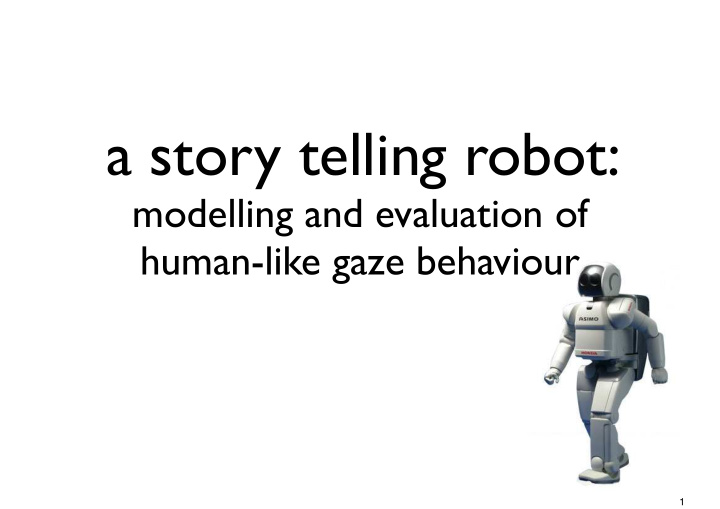



a story telling robot: modelling and evaluation of human-like gaze behaviour 1
motivations • social functions of gaze behaviour • gaze and task performance • previous work on simulating gaze behaviour in agents and robots • How are human-human and human-robot interactions related? 2
social functions • communicating syntactic signals like verbal utterances and emphasis • based on the structure and the content of the utterance. • communicating interpersonal attitude or affect between speaker and listener • indicating speakers attitude 3
task performance • Students were shown to recall significantly better the details of a story when the teacher made eye contact with them/when they received gaze. 4
hypothesis • Participants who are looked at more will perform better in the recall task. • Participant who are looked at more will evaluate ASIMO more positively. 5
the experiment • 20 subjects, 12 males, 8 females • 2 conditions, looked-at 20% of the time, and looked-at 80% of the time • 2 further conditions, male and female! • 4 male and 3 female participants were students of technical majors. • pre and post experimental questionnaires • recall task after listening to another story 6
method • based on Cassell et. al.’s empirical gaze behaviour model: for each proposition do if proposition is theme then if beginning of turn or distribution (0 . 70) then attach a look-away from the listener end if else if proposition is rheme then if end of turn or distribution (0 . 73) then attach a look-toward the listener end if end if end for 7
method • and analyzing gaze data from a professional story teller. Listener 1 Listener 2 Fixed Random spot spot Frequency (%) 13 11 38 38 Length (%) 38 27 30 5 Min (ms) 477 484 242 360 Max (ms) 15,324 5,914 13,674 4,383 Mean (ms) 2,400 2,262 2,640 1,072 Approx. StDev (ms) 500 500 500 250 TABLE I L ENGTH AND DISTRIBUTIONS OF GAZE AT EACH LOCATION . 8
results 9
other results • Positive evaluations of ASIMO were highly correlated with participant’s video gaming experience and not with their computer use. 10
problems • due to physical design of the robot • limited gestures • not completely human like gaze • Some aspects of human story teller’s gaze were not taken into account. 11
Recommend
More recommend